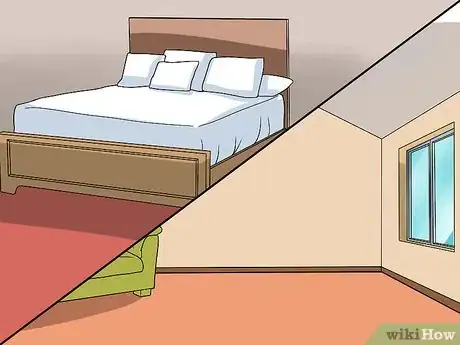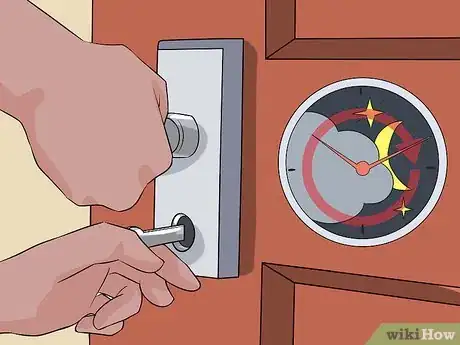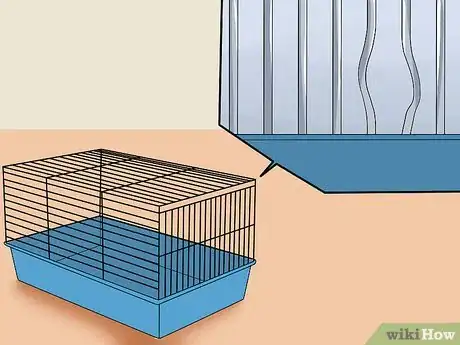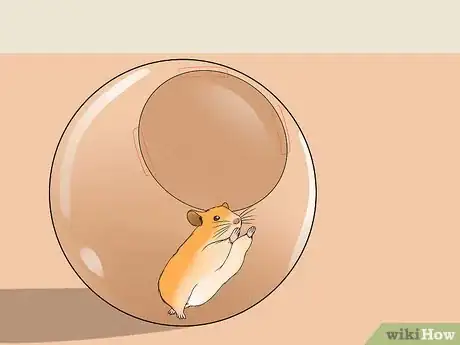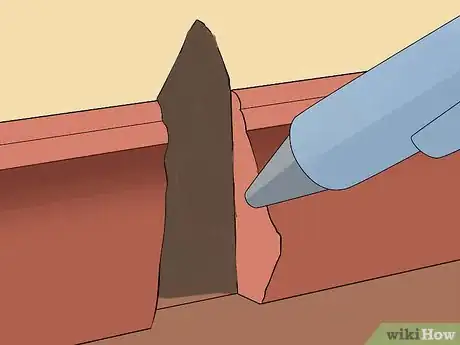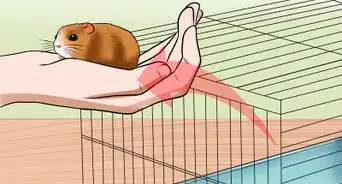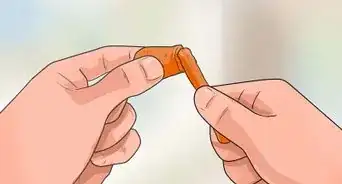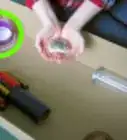This article was co-authored by Pippa Elliott, MRCVS. Dr. Elliott, BVMS, MRCVS is a veterinarian with over 30 years of experience in veterinary surgery and companion animal practice. She graduated from the University of Glasgow in 1987 with a degree in veterinary medicine and surgery. She has worked at the same animal clinic in her hometown for over 20 years.
This article has been viewed 167,240 times.
Losing your hamster can be a very unsettling experience. He could be hiding anywhere, and you may not be sure where to start looking for him. Do not panic, though—keeping focused and having a strategy to find him will help make your search more effective. Fortunately, there are different approaches you can use to locate your hamster.
Steps
Where to Look
-
1Think like a hamster. Approaching your search from a hamster's perspective can help you focus your search. For example, hamsters are very inquisitive animals.[1] If given the chance, a hamster will explore everything in his environment. It is likely that your hamster wasn't trying to escape—he just saw something that piqued his interest.
- Hamsters love food. Your hamster may have made his way into your kitchen because he smelled the food.[2]
- Hamsters are nocturnal. You probably will not have much luck finding your hamster during the day. You may have more success if you start your search late at night.[3]
- Hamsters are timid animals. Even though your hamster probably found a dark and warm place to hide, he would much rather get back to a familiar place, like his cage.[4]
-
2Check the walls and doors of your home for cracks and crevices. When your hamster escaped, he may have found a crack or crevice in which to squeeze. Use a flashlight to look for any possible opening in a wall or door that your hamster could have gotten through.[5]
- Cracks and crevices are more common in older apartments or houses.[6]
- Your hamster may have gotten himself stuck when he squeezed through the crack or crevice.[7] If you are unable to get him out, consider calling an animal removal service for assistance.
- You can try listening for scratching noises in the wall or door to locate where your hamster is hiding.[8]
Advertisement -
3Look everywhere. You will probably need to look underneath, inside, in between, behind, and beside everything in your home. If you think this sounds like a daunting task, then you are right. Hamsters are small animals and will squeeze into just about any small space that offers them a dark, warm, and safe place to hide.[9]
- It may help to first look where you last saw him.[10]
- Consider searching one room at a time to make your search more methodical and efficient.
- In the kitchen, pay special attention to looking inside, underneath, and behind all appliances.[11]
- Do not forget to check bags, shoes, and boxes (including tissue and shoe boxes).[12]
- Laundry bags or baskets may be particularly appealing to your hamster, since they provide a dark and warm place to hide.[13]
- Bookshelves, couch cushions, beds, and chairs are other potential hamster hiding places.[14]
- Because your hamster could have gone anywhere, the list of items and places to check could feel like it is endless. Check every possible place where your hamster could hide, and then think of even more places where he could be.
-
4Restrict your other pets' access. You certainly do not want your cat or dog finding your hamster before you do. When you are finished searching every nook and cranny of one room and are pretty sure that your hamster is not in there, put your other pets in that room.[15] Your other pets may not enjoy being restricted to one room, but it may help your search go a little more smoothly.
- As you search more rooms and determine that your hamster is not in those rooms, you can give your cat or dog less restricted access.
-
5Leave the doors closed overnight. Given his nocturnal nature, your hamster will be most active during the night. Keeping the doors closed will prevent him from running from room to room while you are sleeping.[16]
- Leaving the doors closed may not be as helpful in areas of your home that are more open, such as the kitchen or family room.
Using Food
-
1Select treats that you know your hamster likes. If looking through everything that you can think of has not been successful, try leaving out treats to entice him out of his hiding place. Select hamster-appropriate treats, such as fresh fruit, nuts, and seeds.[17]
- Your hamster may be a little thirsty, depending on how long he's been hiding. Leave out treats with a high moisture content, such as seedless grapes, cucumbers, and apples.[18]
- Peanuts and raisins are also good treats to leave out for your hamster.[19]
- Cut up the treats into small bits to make it easier for your hamster to eat them.
-
2Leave the treats out overnight. You have different options with how to leave the treats out. One option is to put the treats in a saucer or small bowl.[20] You could also put the treats on some newspaper or tinfoil, which would both make noise when your hamster eats the treats.[21] [22]
- Place the treats in areas where you think your hamster is hiding.
- If you decide to stay up late, you could sit quietly near where you placed the newspaper or tinfoil. The noise may help confirm the general area where your hamster is hiding.[23]
- If possible, tie a long string or strand of thread to some of the treats.[24] If your hamster takes the treat back to his hiding place, you may be able to see the string or thread sticking out.[25]
- Count the number of treats you leave out so you can determine if your hamster ate any.
- Be mindful that leaving treats out in multiple areas at the same time could make it more challenging to narrow your search. Your hamster could have moved from one area to the next eating treats.
-
3Sprinkle flour or cornstarch around the area of the treats. Similar to footprints in the snow, your hamster's prints in the flour could direct you to where he is hiding.[26] Make sure not to sprinkle too much flour or cornstarch on the floor—if it's too deep, you may not be able to see your hamster's footprints.
- The further away from the treats that you sprinkle the flour or cornstarch, the better you will be able to track your hamster's movements.
Catching or Trapping
-
1Set your hamster's cage on the floor. Your hamster probably wants to get back to a familiar place. Place the cage where you think your hamster is hiding. Putting some treats in his cage may entice him out of his hiding place and back into his cage.[27]
- Placing the cage sideways on the floor would make it easier for your hamster to climb in.[28] Keep in mind, however, that he could easily walk back out of the cage if he wants to continue exploring.
-
2Set a shallow pail or pan on the floor. If catching your hamster is his cage did not work, then try trapping him (humanely, of course). Place the pail or pan on the floor where you think your hamster is hiding. Put some tasty treats at the bottom to entice your hamster.[29]
- The shallow pail or pan should be shallow enough to lessen the likelihood of your hamster injuring himself, but not so shallow that he could easily climb back out.
- Use books to create a stairwell up to the top of the pail or pan.[30] The books should be fairly small so that your hamster will not struggle with climbing them.
- Once your hamster climbs into the pail or pan to get to the treats, he will not be able to grip the sides to get back out.[31]
-
3Check his cage or trap in the morning. You may be pleasantly surprised to find your hamster sleeping in his cage the morning after you left his cage out.[32] If you set out the trap, you may find him sleeping in the pail or pan.
- If he is not in either the cage or trap, consider moving them to a different potential hiding place and trying again.
Preventing Escape
-
1Inspect the bars of your hamster's cage. The bars of a wire cage can become bent or disconnected over time.[33] With enough persistence, your hamster could squeeze through any widened spaces between the bars. Inspect the bars at least as frequently as you clean your hamster's cage (once a week).[34]
- You can try to manually correct the irregularities in the bars. If this is not practical for you, you can purchase an external wire grid and attach it to the outside of the cage.
-
2Secure the door latch of your hamster's cage. This is especially important for wire cages. To keep himself busy, your hamster may try everything he can to open the door latch.[35] Visit your local pet store to purchase a locking device to keep the door latch securely closed.
-
3Secure the lid of your hamster's cage. Your hamster could use his nose to push open the mesh lid of an aquarium cage. Rather than putting weights on each corner of the lid, which could compromise the cage's air circulation, consider purchasing locking clips at your local pet store.[36]
- You would place the locking clips on each corner of the lid to keep it in place.[37]
-
4Tape the lid of his plastic ball. If you like to place your hamster in a plastic ball so that he can roll around outside his cage, you may to need to reinforce the ball's lid. Lids on plastic balls are typically just pegs that fit into slots. Your hamster may entertain himself by gnawing on the pegs from time to time.[38]
-
5Seal cracks and crevices in your home. If your hamster does get out of his cage, sealing the cracks and crevices would give him fewer places to hide.[41] Your hamster can still hide in plenty of places, but you could minimize the number of areas where he could crawl into and potentially get stuck.
Expert Q&A
Did you know you can get expert answers for this article?
Unlock expert answers by supporting wikiHow
-
QuestionWhat do I do if my hamster cannot be found?
 Pippa Elliott, MRCVSDr. Elliott, BVMS, MRCVS is a veterinarian with over 30 years of experience in veterinary surgery and companion animal practice. She graduated from the University of Glasgow in 1987 with a degree in veterinary medicine and surgery. She has worked at the same animal clinic in her hometown for over 20 years.
Pippa Elliott, MRCVSDr. Elliott, BVMS, MRCVS is a veterinarian with over 30 years of experience in veterinary surgery and companion animal practice. She graduated from the University of Glasgow in 1987 with a degree in veterinary medicine and surgery. She has worked at the same animal clinic in her hometown for over 20 years.
Veterinarian This is unfortunate, but don't give up hope. If the weather is cold, the hamster may be sleepy, so try placing a hot water bottle or another safe source of heat close to where you last saw the hamster. The warmth may attract him. If that fails, leave some "Catch 'em Alive" traps baited with his favorite treat, in places around the house. Once he gets hungry he may be tempted out of hiding.
This is unfortunate, but don't give up hope. If the weather is cold, the hamster may be sleepy, so try placing a hot water bottle or another safe source of heat close to where you last saw the hamster. The warmth may attract him. If that fails, leave some "Catch 'em Alive" traps baited with his favorite treat, in places around the house. Once he gets hungry he may be tempted out of hiding. -
QuestionI lost my hamster outside. How can I find the hamster?
 Pippa Elliott, MRCVSDr. Elliott, BVMS, MRCVS is a veterinarian with over 30 years of experience in veterinary surgery and companion animal practice. She graduated from the University of Glasgow in 1987 with a degree in veterinary medicine and surgery. She has worked at the same animal clinic in her hometown for over 20 years.
Pippa Elliott, MRCVSDr. Elliott, BVMS, MRCVS is a veterinarian with over 30 years of experience in veterinary surgery and companion animal practice. She graduated from the University of Glasgow in 1987 with a degree in veterinary medicine and surgery. She has worked at the same animal clinic in her hometown for over 20 years.
Veterinarian This is tricky, as he may have strayed quite a distance away. Get a "Catch 'em Alive" trap that is used to catch mice without harming them. These traps work by tipping up when the animal goes to the bait, which causes the door to close. Place the trap (or several if possible) close to where you lost the hamster. Bait it with his favorite treat. Hopefully he'll get hungry and be tempted in. Check the traps several times a day.
This is tricky, as he may have strayed quite a distance away. Get a "Catch 'em Alive" trap that is used to catch mice without harming them. These traps work by tipping up when the animal goes to the bait, which causes the door to close. Place the trap (or several if possible) close to where you lost the hamster. Bait it with his favorite treat. Hopefully he'll get hungry and be tempted in. Check the traps several times a day. -
QuestionWhat should I do if I find a dead hamster?
 Pippa Elliott, MRCVSDr. Elliott, BVMS, MRCVS is a veterinarian with over 30 years of experience in veterinary surgery and companion animal practice. She graduated from the University of Glasgow in 1987 with a degree in veterinary medicine and surgery. She has worked at the same animal clinic in her hometown for over 20 years.
Pippa Elliott, MRCVSDr. Elliott, BVMS, MRCVS is a veterinarian with over 30 years of experience in veterinary surgery and companion animal practice. She graduated from the University of Glasgow in 1987 with a degree in veterinary medicine and surgery. She has worked at the same animal clinic in her hometown for over 20 years.
Veterinarian Put on a pair of latex gloves or pick the hamster up in a clean facecloth. If it is your hamster, then you need to decide whether to bury him, take him to the vet for cremation, or dispose of him in the household garbage. If the hamster is not yours, make a note of what he looks like and ask the neighbors if they are missing a pet.
Put on a pair of latex gloves or pick the hamster up in a clean facecloth. If it is your hamster, then you need to decide whether to bury him, take him to the vet for cremation, or dispose of him in the household garbage. If the hamster is not yours, make a note of what he looks like and ask the neighbors if they are missing a pet.
References
- ↑ http://www.healthguidance.org/entry/14536/1/How-to-Find-a-Lost-Hamster.html
- ↑ http://www.healthguidance.org/entry/14536/1/How-to-Find-a-Lost-Hamster.html
- ↑ http://www.healthguidance.org/entry/14536/1/How-to-Find-a-Lost-Hamster.html
- ↑ http://www.healthguidance.org/entry/14536/1/How-to-Find-a-Lost-Hamster.html
- ↑ http://www.smallanimalchannel.com/critter-experts/hamster/lost-hamster.aspx
- ↑ http://www.smallanimalchannel.com/critter-experts/hamster/lost-hamster.aspx
- ↑ http://www.smallanimalchannel.com/critter-experts/hamster/lost-hamster.aspx
- ↑ http://www.smallanimalchannel.com/critter-experts/hamster/lost-hamster.aspx
- ↑ http://www.yourpethamster.com/care/finding
- ↑ http://www.healthguidance.org/entry/14536/1/How-to-Find-a-Lost-Hamster.html
- ↑ http://www.yourpethamster.com/care/finding
- ↑ http://www.yourpethamster.com/care/finding
- ↑ http://www.healthguidance.org/entry/14536/1/How-to-Find-a-Lost-Hamster.html
- ↑ http://www.yourpethamster.com/care/finding
- ↑ http://www.smallanimalchannel.com/critter-experts/hamster/lost-hamster.aspx
- ↑ http://www.yourpethamster.com/care/finding
- ↑ http://www.healthguidance.org/entry/14536/1/How-to-Find-a-Lost-Hamster.html
- ↑ http://www.yourpethamster.com/care/finding
- ↑ http://www.yourpethamster.com/care/finding
- ↑ http://www.yourpethamster.com/care/finding
- ↑ http://www.yourpethamster.com/care/finding
- ↑ http://www.smallanimalchannel.com/critter-experts/hamster/lost-hamster.aspx
- ↑ http://www.yourpethamster.com/care/finding
- ↑ http://www.yourpethamster.com/care/finding
- ↑ http://www.yourpethamster.com/care/finding
- ↑ http://www.healthguidance.org/entry/14536/1/How-to-Find-a-Lost-Hamster.html
- ↑ http://www.yourpethamster.com/care/finding
- ↑ http://www.smallanimalchannel.com/critter-experts/hamster/lost-hamster.aspx
- ↑ http://www.healthguidance.org/entry/14536/1/How-to-Find-a-Lost-Hamster.html
- ↑ http://www.healthguidance.org/entry/14536/1/How-to-Find-a-Lost-Hamster.html
- ↑ http://www.healthguidance.org/entry/14536/1/How-to-Find-a-Lost-Hamster.html
- ↑ http://www.yourpethamster.com/care/finding
- ↑ http://www.smallanimalchannel.com/critter-experts/hamster/hamster-escape-ability-1504.aspx
- ↑ http://www.smallanimalchannel.com/critter-experts/hamster/hamster-escape-ability-1504.aspx
- ↑ http://www.smallanimalchannel.com/critter-experts/hamster/hamster-escape-ability-1504.aspx
- ↑ http://www.smallanimalchannel.com/critter-experts/hamster/hamster-escape-ability-1504.aspx
- ↑ http://www.smallanimalchannel.com/critter-experts/hamster/hamster-escape-ability-1504.aspx
- ↑ http://www.smallanimalchannel.com/critter-experts/hamster/hamster-escape-ability-1504.aspx
- ↑ http://www.smallanimalchannel.com/critter-experts/hamster/hamster-escape-ability-1504.aspx
- ↑ http://www.smallanimalchannel.com/critter-experts/hamster/hamster-escape-ability-1504.aspx
- ↑ http://www.smallanimalchannel.com/critter-experts/hamster/hamster-escape-ability-1504.aspx
- ↑ http://www.smallanimalchannel.com/critter-experts/hamster/lost-hamster.aspx
About This Article
It can be scary to lose your hamster, but if you stay calm and focused, there are things you can do to find it more quickly. Start looking near the cage and work outward, using a flashlight to help you see under furniture and appliances, inside shoes, or inside any cracks or crevices where a hamster could hide. If you don’t find the hamster, try putting out some of its favorite treats, like seedless grapes or a pile of seeds. Since hamsters are nocturnal, leave the treats out at night, and sit quietly nearby so you’ll see when it comes out to eat. Keep reading for tips from our Veterinary co-author on how to use flour to track your hamster’s footprints if you can’t stay up late!


